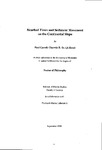Nearbed Flows and Sediment Movement on the Continental Slope
| dc.contributor.author | Chatwin, Paul Gareth | |
| dc.contributor.other | Faculty of Science and Engineering | en_US |
| dc.date.accessioned | 2013-10-07T10:10:12Z | |
| dc.date.available | 2013-10-07T10:10:12Z | |
| dc.date.issued | 1996 | |
| dc.identifier | NOT AVAILABLE | en_US |
| dc.identifier.uri | http://hdl.handle.net/10026.1/2051 | |
| dc.description.abstract |
The steep continental slopes of the southern Celtic shelf have long been thought to be a major export region for the flux of sediment from the south west approaches to the deep ocean (47-49°). Recent studies have suggested that the transfer of energy from the large barotropic tidal currents to internal tides, and higher frequency internal waves is locally enhanced, and provides a mechanism for the re-suspension and downslope transport of bed material on the upper slope region. This material is thought to be preferentially transported at the head of the many submarine canyons that exist along these ocean margins, where the barotropic tidal currents are locally amplified and internal wave energy focused. A unique 23 day deployment of the benthic lander STABLE (Sediment Transport and Boundary Layer Equipment) in July 1990, was at a depth of 388m on La Chapelle Bank continental slope. The site was at the head of a canyon, and at a depth thought to be critical for the generation of internal tidal energy. It was also at the deep water end of a transect of two current meter moorings across the slope. These measurements have shown that during summer stratified conditions the barotropic and baroclinic tides are sufficiently energetic near to the bed to mobilise the sand/gravel sized sediment on the upper slopes and at the shelf break. Eulerian residual bottom currents and maximum tidal currents are orientated cross-slope and this has important implications for sediment transport. The shelf break is predicted to be a region of bed load parting with bedload transport shelfwards at the shelf break and downslope immediately oceanward. On the critical slope region peaks in suspended sediment concentration occur at times of locally enhanced maximum down-slope flow (40cmsˉ¹) and maximum current shear. This suggests that sediment is being eroded from the bed locally and confirms a net flux of material downslope. Above the boundary layer suspended particulate matter will be transported with the net flow of water which is predominantly along-shelf and polewards. A second 10.4 day deployment of STABLE (II) in January 1994 was at a depth of 879m on the Goban Spur. These observations demonstrated the variability of continental slope processes on the margins of the Celtic shelf. During the deployment, weaker tidal currents (maximum of 24cmsˉ¹) were orientated along-slope and there was no evidence to suggest that the fine cohesive sand/mud sized sediment was mobile. Current meter measurements show that any suspended material will be predominantly transported along-slope and poleward. This will be periodically reversed and the net flux will be equatorward. The two studies have highlighted the temporal and alongslope variability of geological and hydrodynamical conditions near to the bed and highlight the difficulties in estimating shelf-ocean fluxes of material across the whole of the north-west European continental margin. | en_US |
| dc.description.sponsorship | Plymouth Marine Laboratory | en_US |
| dc.language.iso | en | en_US |
| dc.publisher | University of Plymouth | en_US |
| dc.title | Nearbed Flows and Sediment Movement on the Continental Slope | en_US |
| dc.type | Thesis | |
| plymouth.version | Full version | en_US |
| dc.identifier.doi | http://dx.doi.org/10.24382/4383 |
Files in this item
This item appears in the following Collection(s)
-
01 Research Theses Main Collection
Research Theses Main


